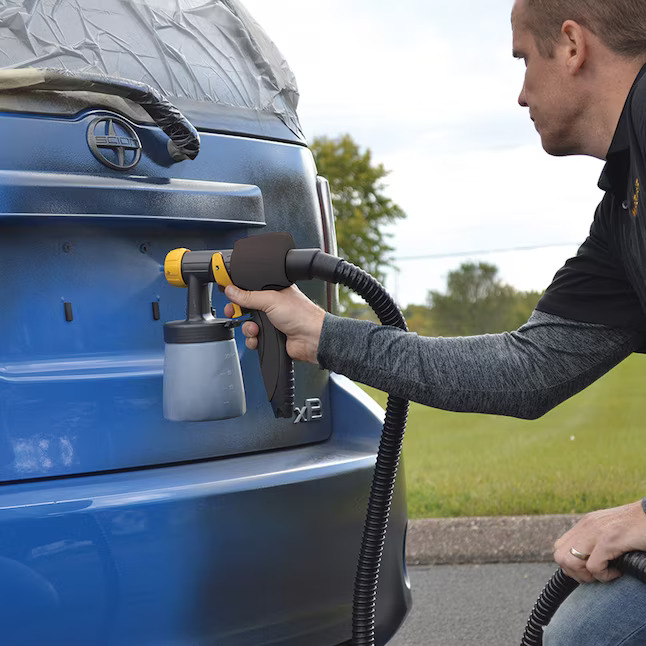
To use a Wagner paint sprayer on a fence, start by preparing the surface and covering any nearby areas you don’t want to paint. Then, follow the manufacturer’s instructions for setting up the sprayer, fill it with the appropriate paint, and begin spraying in even, overlapping strokes for a smooth finish.
Painting your fence can not only enhance its appearance but also provide protection against the elements. Utilizing a Wagner paint sprayer allows for fast and efficient coverage of large surface areas while ensuring a professional finish. In this guide, we will walk you through the process of using a Wagner paint sprayer on your fence, providing you with the knowledge and confidence to achieve a seamless and long-lasting paint job.
Whether you’re a seasoned DIY enthusiast or a first-time fence painter, mastering the use of a paint sprayer can streamline the task and deliver impressive results.
Understanding The Wagner Paint Sprayer
Understanding the Wagner Paint Sprayer is essential before using it to paint a fence. Wagner paint sprayers are popular for their efficiency, ease of use, and professional finish. They come in various types and feature sets, each designed for specific painting tasks. As with any power tool, safety precautions should be a top priority to ensure a smooth and accident-free painting process.
Types And Features
Wagner offers a range of paint sprayers suitable for different project requirements. Among their popular models are the Flexio series, Control series, and the MotoCoat. Each paint sprayer model comes with a unique set of features tailored for specific applications. The Flexio series, for example, is known for its versatility, making it suitable for both indoor and outdoor projects. The Control series, on the other hand, is designed for precision and fine detailing, making it perfect for fence painting. Understanding the specific features of your Wagner paint sprayer model is crucial to achieving the best results.
Safety Precautions
- Before using the Wagner Paint Sprayer, always read the user manual thoroughly to familiarize yourself with the equipment and its safety guidelines.
- Ensure proper ventilation in the painting area to prevent inhalation of paint fumes.
- Wear protective gear, including goggles, gloves, and a mask, to shield yourself from paint overspray.
- Inspect the sprayer for any damage or malfunction before use, and never point the sprayer at yourself or others.
- When operating the sprayer, maintain a safe distance from electrical wires and sources of ignition to prevent accidents.
By understanding the types, features, and safety precautions associated with the Wagner Paint Sprayer, you can effectively and safely utilize this powerful tool for painting your fence.
Preparing The Fence For Painting
Before using a Wagner paint sprayer on your fence, it’s crucial to properly prepare the surface for painting. This involves steps such as cleaning the surface, sanding, and repairing any damages. By following these preparatory steps, you can ensure a smooth and professional finish for your fence.
Cleaning The Surface
The first step in preparing your fence for painting is thoroughly cleaning the surface. A clean surface is crucial for optimal paint adhesion. Use a pressure washer or a hose to remove dirt, grime, and any loose paint. Additionally, consider using a mild detergent or a specialized cleaner to ensure all residue is removed. Be sure to allow the surface to dry completely before proceeding to the next step.
Sanding And Repairing
After the surface is clean and dry, it’s important to inspect the fence for any areas that require sanding and repair. Utilize a coarse sandpaper to smooth out rough or uneven areas, especially where old paint may have chipped or peeled. Pay special attention to any cracks, holes, or splintered areas, and use an appropriate wood filler to repair any damages. Once the filler is dry, smooth the surface with fine-grit sandpaper to ensure a seamless finish.
Using The Wagner Paint Sprayer
When it comes to painting a fence, using a Wagner paint sprayer can save you time and effort while ensuring a professional finish. However, using a paint sprayer effectively requires proper setup and technique to achieve even coverage and a flawless result.
Setting Up The Sprayer
Before using the Wagner paint sprayer on your fence, there are a few essential steps to set up the sprayer for optimal performance:
- Prepare the paint: Thoroughly mix the paint according to the manufacturer’s instructions and strain it to remove any lumps or debris that could clog the sprayer.
- Adjust the spray pattern: Depending on the size and type of your fence, select the appropriate spray pattern (horizontal, vertical, or round) and adjust the nozzle to achieve the desired coverage.
- Check the pressure: Ensure that the sprayer’s pressure is adjusted to the recommended setting for the type of paint you are using. Consult the paint manufacturer’s guidelines for the correct pressure level.
- Protect surrounding areas: Cover nearby plants, grass, and other surfaces to prevent overspray from reaching unintended areas.
- Prime the sprayer: Before loading the paint, prime the sprayer according to the manufacturer’s instructions to remove any air from the system and ensure a smooth flow of paint.
Technique For Even Coverage
Once the Wagner paint sprayer is properly set up, the right technique is crucial to achieving even coverage and a professional finish on your fence:
- Start from one end: Begin spraying from one end of the fence, holding the sprayer perpendicular to the surface and maintaining a consistent distance to ensure a uniform application of paint.
- Overlap strokes: Overlap each pass by about 50% to avoid missing spots and guarantee a thorough and even coating across the entire surface of the fence.
- Maintain a steady pace: Move the sprayer at a steady speed to prevent excessive build-up of paint in one area, which can result in drips or uneven coverage.
- Adjust technique for different areas: When painting corners or detailed areas, adjust the sprayer’s angle and distance to ensure complete coverage without overspraying onto adjacent surfaces.
- Apply multiple coats if necessary: For thorough coverage and a more durable finish, consider applying multiple thin coats rather than a single heavy coat.
Tips For Efficient Painting
When it comes to painting a fence, using a Wagner paint sprayer can be a game-changer in terms of efficiency and achieving professional results. To ensure the painting process goes smoothly and effectively, it’s important to implement certain tips for efficient painting. In this guide, we’ll focus on managing overspray and maximizing paint usage when using a Wagner paint sprayer on a fence.
Managing Overspray
One of the key challenges when using a paint sprayer on a fence is managing overspray. This can lead to wastage of paint, uneven coverage, and potential damage to surrounding areas. To minimize overspray and ensure precise application:
- Adjust the Spray Pattern: Set the sprayer to a narrow pattern to control overspray and direct the paint precisely onto the fence surface.
- Use Masking and Covering: Securely cover surrounding areas with drop cloths, plastic sheets, or masking tape to protect them from overspray.
- Work in Sections: Divide the fence into manageable sections and focus on one area at a time to maintain control over the application and minimize overspray.
- Practice Proper Technique: Hold the sprayer at the correct distance from the fence and apply paint in smooth, overlapping strokes to reduce overspray.
Maximizing Paint Usage
Efficient use of paint is crucial to complete the painting project without running out of paint or incurring unnecessary costs. To maximize paint usage when using a Wagner paint sprayer on a fence:
- Thin the Paint Appropriately: Follow the manufacturer’s recommendations for thinning the paint to the right consistency, ensuring optimal coverage without overspraying excessive paint.
- Optimize Sprayer Settings: Adjust the sprayer settings to control the amount of paint released, ensuring efficient utilization and minimizing wastage.
- Use a Paint Strainer: Before pouring paint into the sprayer, strain it to remove any impurities or particles that may clog the sprayer’s nozzle, leading to wastage.
- Plan the Coverage: Estimate the amount of paint required based on the fence size and plan the coverage to avoid running out of paint or having excessive leftovers.
Maintenance And Cleanup
Proper maintenance and cleanup of your Wagner paint sprayer after use is crucial for ensuring its longevity and optimal performance. By following a few simple steps, you can keep your sprayer in top condition and ready for the next project.
Cleaning The Sprayer
After each use, it’s essential to thoroughly clean the paint sprayer to prevent any clogs or malfunctions. Here’s a simple step-by-step guide to cleaning your Wagner paint sprayer:
- Flush the System: Start by flushing any remaining paint out of the system. Fill the paint cup with water, attach it to the sprayer, and run the sprayer until clear water sprays out. Repeat this process until the water runs completely clear.
- Disassemble and Clean: Once the system is flushed, disassemble the sprayer and clean each individual component thoroughly with warm, soapy water. Pay special attention to the nozzle and any paint channels to remove any leftover residue.
- Inspect and Reassemble: After cleaning, carefully inspect each part for any remaining paint or debris. Once satisfied, reassemble the sprayer according to the manufacturer’s instructions.
Proper Storage And Care
In addition to cleaning, proper storage and care of your Wagner paint sprayer are essential for extending its lifespan. Here are a few tips for storing and maintaining your sprayer:
- Complete Drying: Ensure all components are completely dry before storing the sprayer to prevent any potential rust or mold issues.
- Cover and Protect: When not in use, store the sprayer in a dry, dust-free environment. Consider covering it with a cloth or plastic sheet to protect it from damage.
- Regular Inspection: Periodically inspect the sprayer for any signs of wear or damage, and address any issues promptly to prevent further deterioration.

Frequently Asked Questions On How To Use A Wagner Paint Sprayer On A Fence
How Do I Prepare My Fence For Painting With A Wagner Sprayer?
To prepare your fence for painting with a Wagner sprayer, start by cleaning the surface thoroughly to remove dirt and debris. Then, sand any rough areas and make sure the surface is completely dry before painting to ensure a smooth finish.
What Type Of Paint Is Best For A Fence When Using A Wagner Sprayer?
When using a Wagner sprayer on a fence, it’s best to use an exterior latex paint. This type of paint is durable, weather-resistant, and provides excellent coverage. Be sure to choose a paint specifically designed for outdoor use to ensure long-lasting results.
Can A Wagner Sprayer Be Used On Both Wooden And Metal Fences?
Yes, a Wagner sprayer can be used on both wooden and metal fences. It’s important to adjust the sprayer settings and choose the appropriate spray tip based on the material of your fence. With the right setup, you can achieve professional results on various fence types.
How Can I Achieve A Smooth, Even Finish When Painting My Fence With A Wagner Sprayer?
To achieve a smooth, even finish with a Wagner sprayer, it’s essential to use steady, overlapping strokes while spraying. Maintain a consistent distance from the fence surface and work in small sections to ensure thorough coverage. Proper technique and adjustment of the sprayer settings are key to a professional-looking result.
Conclusion
Using a Wagner paint sprayer on a fence can be a game-changer for your outdoor renovation projects. By following the right techniques and proper maintenance, you can achieve professional-looking results in no time. With its efficiency and ease of use, this tool is a valuable addition to any DIY enthusiast’s arsenal.






